Chapter 15
Marketing Yourself and Your Business
In This Chapter
![]() Exploring marketing strategies for yourself and your business
Exploring marketing strategies for yourself and your business
![]() Getting recommendations for your professional services
Getting recommendations for your professional services
![]() Locating marketing partners and doing market research
Locating marketing partners and doing market research
In this part of the book, you find out how to start applying everything the previous parts cover about how to use LinkedIn for specific situations and needs. After all, every great invention needs to fulfill some sort of purpose, and LinkedIn is no exception. Its value is not just in how it allows you to network and build your brand, but also in how you can use LinkedIn to handle other tasks more easily and effectively.
I start with the age-old discipline of marketing. In this chapter, I discuss how to generate sales and how LinkedIn can affect your entire sales cycle. LinkedIn can help you “spread the gospel” of your business mission by serving as a vehicle for positive and rich marketing messages about both you and your business, whether it's a start-up, personal service provider, or a Fortune 500 company. Part of the power of LinkedIn comes from involving others in your marketing initiatives, so I cover some ways for you to do that as well.
Marketing Yourself Through LinkedIn
When it comes to maximizing the benefit you receive from LinkedIn, you are your biggest advocate. Although your network of connections is instrumental in helping you grow, much of your marketing happens without your being involved. After you create your profile, that and any other LinkedIn activity of yours are read and judged by the community at large — on the other members’ own time and for their own purposes. Therefore, you want to make sure you're creating a favorable impression of yourself by marketing the best traits, abilities, and features of you and your business. Because of the nature of LinkedIn, this marketing occurs continually — 24/7. So, you should look at LinkedIn as something to check and update on a continual basis, like a blog. It doesn't mean you have to spend hours each day on LinkedIn, but a little bit of time on a consistent basis can go a long way toward creating a favorable and marketable LinkedIn identity.
The following sections look at the different ways you interact with LinkedIn, and what you can do to create the most polished, effective LinkedIn identity possible to further your marketing message.
Optimizing your profile
In Chapter 3, I discuss building your professional profile on LinkedIn, which is the centerpiece of your LinkedIn identity and your personal brand. I refer to your profile throughout this book, but here, I focus on ways for you to update or enhance your profile with one specific goal in mind: marketing yourself better or more consistently. As always, not every tip or suggestion works for everyone, and you might have already put some of these into action, but it's always good to revisit your profile to make sure it's organized the way you intended.
To make sure your profile is delivering the best marketing message for you, consider these tips:
- Use the Professional headline wisely. Your Professional headline is what other LinkedIn users see below your name even when they're not looking at your full profile. I've seen some users stuff a lot of text into this field, so you should have enough space to communicate the most important things about yourself. If you have specific keyword phrases you want associated with your name, make them a part of your headline.
A standard headline reads something like “Software Development Manager at XYZ Communications,” but you can write entire sentences full of great keywords for your headline. My client Liz Goodgold's headline reads “Branding and Marketing Expert, Author, Coach, and Motivational Speaker.” Think about how many people would want to connect with her!
- Make sure you use keyword phrases that match popular keywords for you or your business. The first step, as I just mentioned, is to put these phrases in your headline. The second step is to make sure these phrases are reflected in your Summary, Experiences, and Interests.
 Be careful not to overuse your main keyword phrases. The search engines call this practice “stuffing,” which is cramming as many instances of a phrase into your site as possible in hopes of achieving a higher ranking. If the search engines detect this, you will experience lower ranking results.
Be careful not to overuse your main keyword phrases. The search engines call this practice “stuffing,” which is cramming as many instances of a phrase into your site as possible in hopes of achieving a higher ranking. If the search engines detect this, you will experience lower ranking results. - If you're available for freelance work, make sure to identify at least one of your current positions as freelance or self-employed. Remember, people aren't mind readers, so you need to let people know that you're a freelance writer, Web site designer, dog walker, or whatever. If you look at Cynthia Beale's profile in Figure 15-1, you can see that she's listed her current position as self-employed.
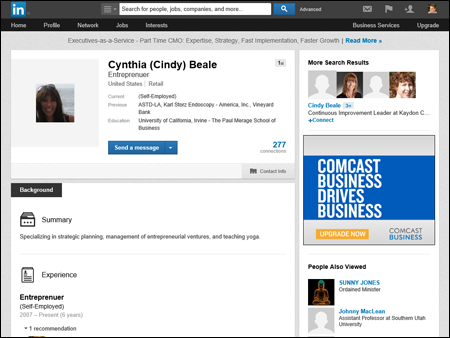
Figure 15-1: Make sure to note if you are self-employed or freelance.
- Use the additional sections in your profile to include any relevant information that reinforces your marketing message. For example, if you want to be seen as an expert in a given field, add the SlideShare application to upload presentations you've given, or update the Publications section of your profile to include the articles or books you've written, articles you've been quoted in, focus or advisory groups you belong to, and any speaking engagements or discussions you've participated in. LinkedIn has created sections like Projects, Patents, and Certifications for you to display specific accomplishments that are an important part of your professional identity.
- Make sure your profile links to your Web sites, blogs, and any other part of your online identity. Don't just accept the standard “My Company” text. Instead, select the Other option, and put your own words in the Web site title box, such as “Joel Elad's E-Commerce Education Web site.” (See Chapter 3 for more information on linking from your profile to other Web sites.)
For an example of effectively linking your profile to other areas of your online presence, take a look at Scott Allen's profile, shown in Figure 15-2. His three Web site links replace the bland My Company, My Blog, and My Website with his own text — Momentum Factor, Linked Intelligence, and Social Media Is My Middle Name. Not only does this give more information to someone reading his profile, but search engines have a better idea of what those links represent.
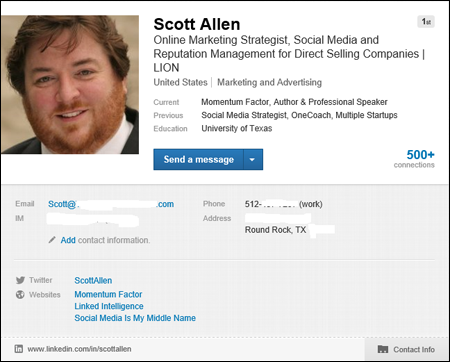
Figure 15-2: Give your Web site links meaningful names.
Marketing yourself to your network
Optimizing your profile in the ways described in the previous section is one of the best ways to market yourself effectively using LinkedIn. Another is to be alert to how well you're communicating with your LinkedIn connections. Whether it's automatic (like when you update your profile and LinkedIn automatically notifies your network through a network update) or self-generated (when you use LinkedIn InMail or introductions to send a note to someone else, which I cover in Chapter 5), this communication becomes your ongoing message to the members of your network and keeps you in their minds and (you hope!) plans.
The most effective marketing occurs when people don't realize you're marketing to them. After all, the average American sees all kinds of marketing messages throughout their day. Your goal is to communicate often but not be overbearing about it so your message subtly sinks into people's minds. If you do that, people will think you're grrrr-eat! (Hmm, why am I suddenly hungry for cereal?)
So when you're contemplating how to effectively communicate with your network connections, keep these points in mind:
- Update your profile when appropriate. Updating your profile means that you're sending an update of your newest projects to your network so that your connections can consider involving you in their own current or future projects. You don't need to update your profile as often as you update a blog, but you certainly don't want to leave your profile untouched for months on end, either. Useful times to update your profile include
- Getting a new job or promotion
- Starting a new freelance or contract job
- Launching a new company or venture
- Adding a missing piece of your Experience section, such as adding a new position, updating the description of an existing job, or clarifying the role of a group or interest on your profile
- Receiving an award or honor for your professional, nonprofit, or volunteer work
- Being appointed to a board of directors or elected to a professional association board
- Taking on new responsibilities or duties in any of your endeavors
- Take advantage of the Network Update feature. When you specify your current endeavors, several things happen. Your profile reflects what you enter here, your network connections see what you enter here when they read their network updates about you (see Chapter 9 for more on network updates), and you start to build your own microblog, in a sense, because people can follow your natural progression.
 A similar example of a microblog is Twitter. As you update your Twitter profile with 140-character messages, other people can follow your activities and even subscribe to these updates. Tie your Twitter updates to your LinkedIn account, so if you “tweet” on Twitter, those updates are automatically reflected on your LinkedIn profile.
A similar example of a microblog is Twitter. As you update your Twitter profile with 140-character messages, other people can follow your activities and even subscribe to these updates. Tie your Twitter updates to your LinkedIn account, so if you “tweet” on Twitter, those updates are automatically reflected on your LinkedIn profile.Some people use the Network Update feature to let people know that “Joel is getting ready for his next project” or “Joel is finishing up his first draft of LinkedIn For Dummies.” Other people use the messages to show progression of a certain task, like “Joel is currently conducting interviews for an Executive Assistant position he is trying to fill,” then “Joel is narrowing down his choices for Executive Assistant to two finalists,” and finally “Joel has made an offer to his top choice for Executive Assistant.” See Chapter 9 for more on how to use this feature.
- Search for, and join, any relevant LinkedIn Groups that can help you reach your target audience. It's a good idea to participate in these groups, but whatever you do, don't immediately download a list of all group members and spam them with LinkedIn messages. When you join the group, you're indicating your interest in that group because your profile now carries that group logo. Membership in such groups gives you access to like-minded people you should be communicating with and adding to your network. Spend some time every week or every month checking out LinkedIn Groups and networking with group members to grow your network. See Chapter 14 for more about LinkedIn Groups.
- Participate on a regular and consistent basis. The easiest way to ensure a steady stream of contact with as many people as you can handle is to dedicate a small but fixed amount of time to regularly interact with the LinkedIn community. Some members spend 15 to 30 minutes per day, sending messages to their connections, reading through the Groups and Companies or Influencers page, or finding one to two new people to add to their network. Others spend an hour a week, or as long as it takes to create their set number of recommendations, invite their set number of new contacts, or reconnect with their set number of existing connections. You just need to establish a routine that works with your own schedule.
Marketing Your Business Through LinkedIn
LinkedIn can play a significant role in the effective marketing of your business. LinkedIn's value as a marketing tool gets a lot of buzz from most companies’ finance departments, especially because they see LinkedIn as a free way of marketing the business. Although you don't have to pay anything in terms of money to take advantage of most of LinkedIn's functions, you do have to factor in the cost of the time you put in to manage your profile and use LinkedIn to the fullest.
Currently, LinkedIn offers your company promotion through its Company pages section. LinkedIn ties status updates, job titles, and other pertinent information from company employees’ profiles directly into the Company page. From each page, you can see those people you know in the company, open career positions, recent updates from their employees, and other pertinent facts.
If you're a small business, you can create your own Company page. You need to have your company e-mail address in your LinkedIn profile and be established as a current employee/manager/owner of that company in your profile as well. Click the Interest link from the top navigation bar, and then click Companies from the drop-down list that appears to learn more.
Using online marketing tactics with LinkedIn
Marketing your business on LinkedIn involves working through your own network, employing both your current list of contacts as well as potential contacts in the greater LinkedIn community. Your efforts should also include making use of links from your online activities to your LinkedIn profile and promoting your business online from your LinkedIn identity. Here are some things to keep in mind as you develop your LinkedIn marketing strategy:
- Encourage every employee to have a LinkedIn profile and to link to each other. Extending your network in this way increases your exposure outside your company. And if anybody in your organization is nervous about preparing her profile, just tell her that LinkedIn can be an important asset in their professional or career development. You can mention that even Bill Gates has a LinkedIn profile. That should do the trick! (And then buy her a copy of this book to get her started.)
- Make sure your business Web sites and blogs are linked to your LinkedIn profile. By offering your Web site visitors a direct view to your LinkedIn profile, you're allowing them to verify you as an employee of the company because they can see your experience and recommendations from other people. They might also realize they share a bond with you and your business that they never would have discovered without LinkedIn.
- Make sure your LinkedIn profile links back to your business Web site and blog. You not only want your visitors and potential customers to be able to verify who you are, but you also want them to go back to your Web site and do some business with you! Make sure that you, and every employee of your company who's on LinkedIn, includes a link to your business's Web site and, if there is one, the company blog.
 If you have a search engine expert working for you, that person may complain about something called a two-way link, which is a link from your LinkedIn profile to your Web site and a link from your Web site to your LinkedIn profile. This practice, known as reciprocal linking, hurts your search engine ranking. If so, have that person identify which of the two links is more important and implement only that link.
If you have a search engine expert working for you, that person may complain about something called a two-way link, which is a link from your LinkedIn profile to your Web site and a link from your Web site to your LinkedIn profile. This practice, known as reciprocal linking, hurts your search engine ranking. If so, have that person identify which of the two links is more important and implement only that link. - Make sure that your most popular keyword phrases are in your company or personal profile. Use sites such as Wordtracker (www.wordtracker.com) or Good Keywords (www.goodkeywords.com) to find the hottest keyword phrases in your field. If your business is doing any online ad campaigns, make sure those keyword phrases are the same as the ones in your profile. Presenting a consistent image to potential customers makes you and your company look more professional.
- Develop relationships with key business partners or media contacts. When you search for someone on LinkedIn, you can be precise about who you want to reach. So, for example, if you know that your business needs to expand into the smartphone market, you can start targeting and reaching out to smartphone companies such as Apple, Samsung (maker of the Galaxy and Note), and HTC (maker of the One). If you want to increase your visibility, start reaching out to media members who cover your industry.
Promoting your services through a recommendation
Now, you may ask, “What if I am my business?” If you provide a professional service, such as consulting or freelance writing (to name just a few), be sure to take advantage of the fact that LinkedIn can classify you as a service provider. There are categories and subcategories of service providers that range from computer-related consultants to attorneys, accountants, and real estate agents. Although you can no longer search exclusively for a service provider, your recommendations for any service position still show up in your profile, which can be visible when people search LinkedIn, making it a potentially valuable addition to your business.
To request a recommendation from someone, just follow these steps:
- Click the word Profile in the top navigation bar, then click Edit Profile from the menu that appears. From your profile page, scroll down to the Recommendations section and click the Edit link (the pencil icon) to open up that section.
You see an expanded view of your recommendations, as shown in Figure 15-3, along with the Ask to Be Recommended link on the right side of the screen.
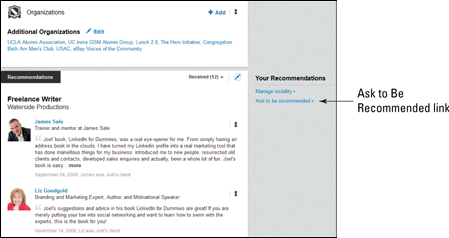
Figure 15-3: Start by editing the Recommendations section of your profile.
- Click the Ask to Be Recommended link to bring up the Ask for Recommendations page, shown in Figure 15-4.
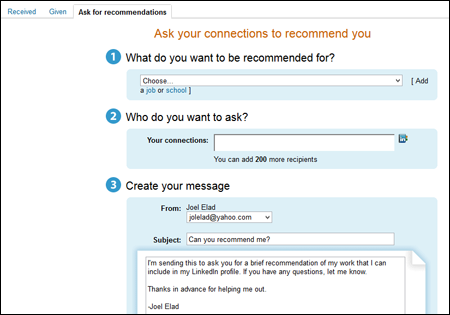
Figure 15-4: Start your service provider recommendation request.
- In the What Do You Want to Be Recommended For section, click the arrow for the drop-down list to find the position you want someone to recommend you for.
If you want your Services recommendation to be tied to a specific role, pick one of your positions that indicates that service, such as Freelance Writer or Web site Designer. If you don't see an appropriate position in your list, click the Add a Job or School link to add a new position to the Experience section of your profile. (For more information on how to update your profile, see Chapter 3.)
- In the Who Do You Want to Ask section, start typing the names of people to ask for a recommendation.
As you type those people's names, LinkedIn prompts you with the full name of that person. Click that prompt to have LinkedIn add that person to the list.
- Repeat Step 4 until you add all the people you wish to ask for a recommendation.
- In the Create Your Message section, type a note to send to each person you selected, similar to the example shown in Figure 15-5.
Although LinkedIn fills in this box with canned text (as shown in Figure 15-5), I recommend you personalize this text to make it sound as though it's coming from you. Most importantly, you should use this message to emphasize to the recommender what areas you are hoping they will comment on regarding your service. It's not about feeding them a speech to say about you, but pointing them to the areas you want mentioned in their recommendation.
 Make sure the Subject line is appropriate, too, to help your chances of getting your intended requesters to actually open the e-mail and respond.
Make sure the Subject line is appropriate, too, to help your chances of getting your intended requesters to actually open the e-mail and respond.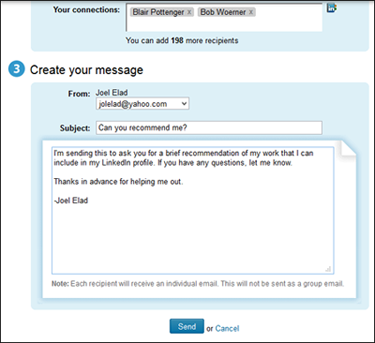
Figure 15-5: Ask your network connections for a recommendation.
- Click Send.
Your request is sent, and your selected connections receive a message from LinkedIn asking them to come to the site and complete a recommendation for you.
That's it! For information on how to complete a recommendation for someone who requests one from you, check out Chapter 8.
Finding Marketing Partners Through LinkedIn
When it comes to marketing on LinkedIn, your strategy typically involves more than just you and your business. Part of the success of marketing through LinkedIn is finding the right marketing partners to help you with your goals and take you to the next level. After all, you're connecting with like-minded professionals who have skills similar or complementary to yours, which helps both of you achieve your goals. In some cases, finding the right partner can make a big difference in the growth of your business, as I found out by interviewing Kristie Spilios, profiled in the following sidebar.
Odds are, you won't have all the answers when it comes to your strategic plan, marketing plan, or maybe even your business direction. Thankfully, when you're using LinkedIn, you're definitely not alone. LinkedIn allows you to search the collective knowledge of its community, enabling you to perform some market research on a variety of topics and get real-time responses without involving think tanks or putting out thousands of dollars in fees.
The key is to be honest, transparent, and (as odd as this might sound) grateful. After all, you are asking for people's advice and thoughts, so don't expect them to write a 30-page market analysis for you for free. Share your goals and intentions as a network update, get people discussing the idea and each other's comments, and be ready to listen. The best research results from the community's exchange of ideas, with a bunch of voices chiming in to validate or discount the theorem of the moment.
